The NVIDIA GeForce GTX 780 Ti Review
by Ryan Smith on November 7, 2013 9:01 AM ESTHands On With NVIDIA's Shadowplay
Though it’s technically not part of the GeForce GTX 780 Ti launch, before diving into our typical collection of benchmarks we wanted to spend a bit of time looking at NVIDIA’s recently released Shadowplay utility.
Shadowplay was coincidentally enough first announced back at the launch of the GTX 780. Its designed purpose was to offer advanced game recording capabilities beyond what traditional tools like FRAPS could offer by leveraging NVIDIA image capture and video encode hardware. In doing so, Shadowplay would be able to offer similar capabilities with much less overhead, all the while also being able to utilize the NVENC hardware H.264 encoder to encode to space efficient H.264 rather than the bulky uncompressed formats traditional tools offer.
With Shadowplay and NVIDIA’s SHIELD streaming capabilities sharing so much of the underlying technology, the original plan was to launch Shadowplay in beta form shortly after SHIELD launched, however Shadowplay ended up being delayed, ultimately not getting its beta release until last week (October 28th). NVIDIA has never offered a full accounting for the delay, but one of the most significant reasons was because they were unsatisfied with their original video container choice, M2TS. M2TS containers, though industry standard and well suited for this use, have limited compatibility, with Windows Media Player in particular being a thorn in NVIDIA’s side. As such NVIDIA held back Shadowplay in order to convert it over to using MP4 containers, which have a very high compatibility rate at the cost of requiring some additional work on NVIDIA’s part.
In any case with the container issue resolved Shadowplay is finally out in beta, giving us our first chance to try out NVIDIA’s game recording utility. To that end while clearly still a beta and in need of further polishing and some feature refinements, at its most basic level we’ve come away impressed with Shadowplay, with NVIDIA having delivered on all of their earlier core promises for the utility
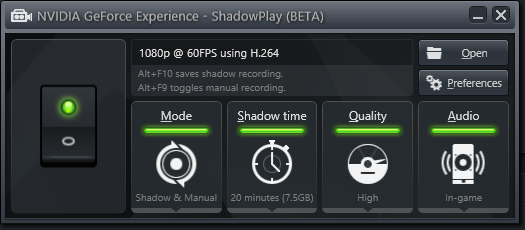
With regards to functionality, all of Shadowplay’s basic functionality is in. The utility offers two recording modes: a manual mode and a shadow mode, the former being self-explanatory while the latter being an always-active rolling buffer of up to 20 minutes that allows saving the buffer after the fact in a DVR-like fashion. Saving the shadow buffer causes the entirety of the buffer to be saved and a new buffer started, while manual mode can be started and stopped as desired.
| Shadowplay Average Bitrates | |||
| High Quality | 52Mbps | ||
| Medium Quality |
23Mbps
|
||
| Low Quality |
16Mbps
|
||
Next to being able to control the size of the shadow buffer, Shadowplay’s other piece of significant flexibility comes through the ability to set the quality (and therefore file size) of the recordings Shadowplay generates. Since Shadowplay uses lossy H.264 the recording bitrates will scale with the quality, with Shadowplay offering 3 quality levels: high (52Mbps), medium (23Mbps), and low (16Mbps). Choosing between the quality levels will depend on the quality needed and what the recording is intended for, due to the large difference in quality and size. High quality is as close as Shadowplay gets to transparent compression, and with its large file sizes is best suited for further processing/transcoding. Otherwise Medium and Low are low enough bitrates that they’re reasonably suitable for distribution as-is, however there is a distinct quality tradeoff in using these modes.
Moving on, at this moment while Shadowplay offers a range of quality settings for recording it only offers a single resolution and framerate: 1080p at 60fps. Neither the frame rate nor the resolution is currently adjustable, so whenever you record and despite the resolution you record from, it will be resized to 1920x1080 and recorded at 60fps. This unfortunately is an aspect-ratio unaware resize too, so even non-16:9 resolutions such as 1920x1200 or 2560x1600 will be resized to 1080p. Consequently at this time this is really the only weak point for Shadowplay; while the NVENC encoder undoubtedly presents some limitations, the inability to record at just a lower resolution or in an aspect ratio compliant manner is something we’d like to see NVIDIA expand upon in the final version of the utility.
Finally, let’s talk about performance. One of Shadowplay’s promises was that the overhead from recording would be very low – after all, it needs to be low enough to make always-on shadow mode viable – and this is another area where the product lives up to NVIDIA’s claims. To be sure there’s still some performance degradation from enabling Shadowplay, about 5% by our numbers, but this is small enough that it should be tolerable. Furthermore Shadowplay doesn’t require capping the framerate like FRAPS does, so it’s possible to use Shadowplay and still maintain framerates over 60fps. Though as to be expected, this will introduce some frame skipping in the captured video, since Shadowplay will have to skip some frames to keep within its framerate limitations.
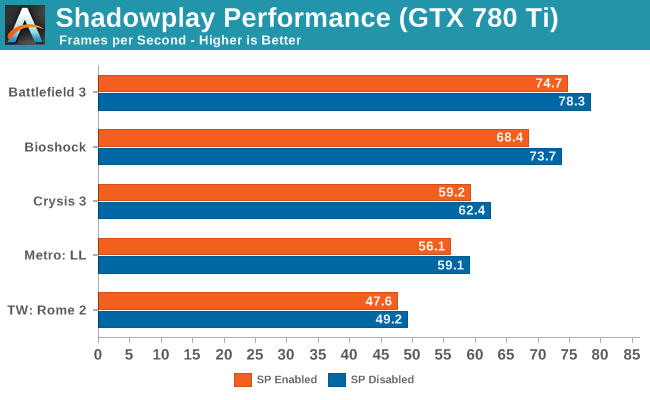
On a related note, we did some digging for a technical answer for why Shadowplay performs as well as it does, and found our answer in an excellent summary of Shadowplay by Alexey Nicolaychuk, the author of RivaTuner and its derivatives (MSI Afterburner and EVGA Precision). As it turns out, although the NVENC video encoder plays a part in that – compressing the resulting video and making the resulting stream much easier to send back to the host and store – that’s only part of the story. The rest of Shadowplay’s low overhead comes from the fact that NVIDIA also has specific hardware and API support for the fast capture of frames built into Kepler GPUs. This functionality was originally intended to facilitate GRID and game streaming, which can also be utilized for game recording (after all, what is game recording but game streaming to a file instead of another client?).
This functionality is exposed as Frame Buffer Capture (NVFBC) and Inband Frame Readback (NVIFR). NVFBC allows Shadowplay to pull finished frames straight out of the frame buffer directly at a low level, as opposed to having to traverse the graphics APIs at a high level. Meanwhile NVIFR does have operate at a slightly higher level to inject itself into the graphics API, but in doing so it gains the flexibility to capture images from render targets as opposed to just frame buffers. Based on what we’re seeing we believe that NVIDIA is using NVFBC for Shadowplay, which would be the lowest overhead option while also explaining why Shadowplay can only capture full screen games and not windowed mode games, as frame buffer capturing is only viable when a game has exclusive control over the frame buffer.
Wrapping things up, it’s clear that NVIDIA still has some polishing they can apply to Shadowplay, and while they aren’t talking about the final release this soon, as a point of reference it took about 4 months for NVIDIA’s SHIELD game streaming component to go from beta to a formal, finished release. In the interim however it’s already in a very usable state, and it should be worth keeping an eye on in the future to see what else NVIDIA does to further improve the utility.
The Test
The press drivers for the launch of the GTX 780 Ti are release 331.70, which other than formally adding support for the new card is otherwise identical to the standing 331.65 drivers.
Meanwhile on a housekeeping note, we want to quickly point out that we’ll be deviating a bit from our normal protocol and including the 290X results for both normal (quiet) and uber modes. Typically we’d only include results from the default mode in articles such as these, but since we need to cover SLI/Crossfire performance and since we didn’t have 290X CF quiet mode results for our initial 290X review, we’re throwing in both so that we can compare the GTX 780 Ti to the 290X CF without being inconsistent by suddenly switching to the lower performance quiet mode numbers. Though with that said, for the purposes of our evaluation we will be focusing almost entirely on the quiet mode numbers, given the vast difference in both performance and noise that comes from using it.
| CPU: | Intel Core i7-4960X @ 4.2GHz |
| Motherboard: | ASRock Fatal1ty X79 Professional |
| Power Supply: | Corsair AX1200i |
| Hard Disk: | Samsung SSD 840 EVO (750GB) |
| Memory: | G.Skill RipjawZ DDR3-1866 4 x 8GB (9-10-9-26) |
| Case: | NZXT Phantom 630 Windowed Edition |
| Monitor: | Asus PQ321 |
| Video Cards: |
AMD Radeon R9 290X AMD Radeon R9 290 XFX Radeon R9 280X Double Dissipation AMD Radeon HD 7990 AMD Radeon HD 7970 NVIDIA GeForce GTX Titan NVIDIA GeForce GTX 780 Ti NVIDIA GeForce GTX 780 NVIDIA GeForce GTX 770 |
| Video Drivers: |
NVIDIA Release 331.58 WHQL NVIDIA Release 331.70 Beta AMD Catalyst 13.11 Beta v1 AMD Catalyst 13.11 Beta v5 AMD Catalyst 13.11 Beta v8 |
| OS: | Windows 8.1 Pro |


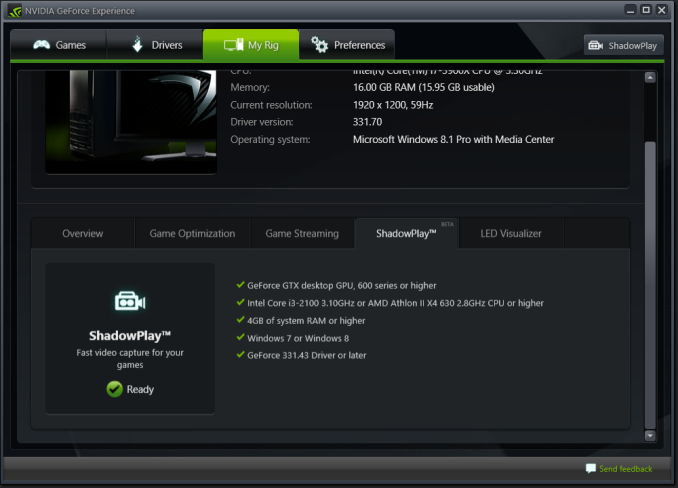
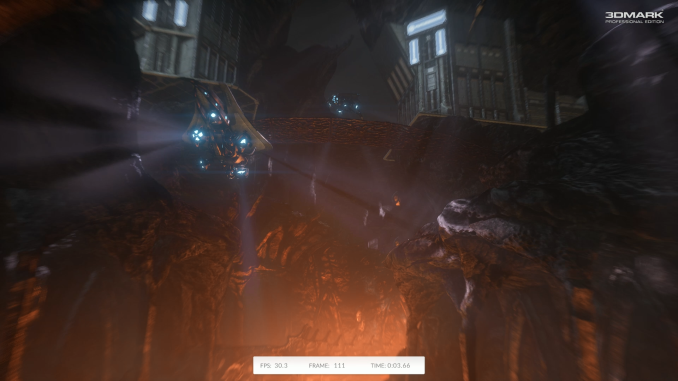

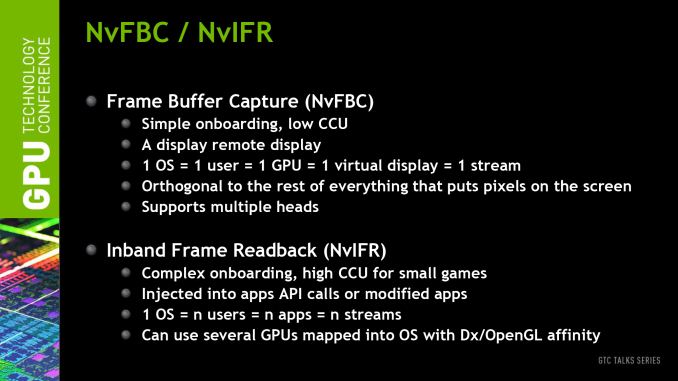














302 Comments
View All Comments
Owls - Thursday, November 7, 2013 - link
Ryan I'm sorry but the video card reviews as of late have been very poor in quality and objectivity. Stop rushing to be the first. I don't go to Anand to read a crappy review, that's what HardOCP is for.That said your testing is flawed with old games and comparing the Ti to be faster than a 290x that is in silent mode is disingenuous. We all expect better from this site.
nsiboro - Friday, November 8, 2013 - link
True - unfortunate wordings. But we gotta learn to read between the lines e.g. 780ti cannot be compared to 290/X. :)nunomoreira10 - Thursday, November 7, 2013 - link
totallywhy does he even compare the non "uber" 290x to the 780TI
its very misleading when he says it´s 11% faster then 290x not pointing out the fact that it was in silent mode.
also not sure which drivers were used on the 290x
hoboville - Thursday, November 7, 2013 - link
Sigh, I've always had good experiences with Nvidia products. They have always been good to me, but the pricing nonsense of GK110 has really put me off, a lot. I get it, you have the best so you charge people for the best, but all this does is put performance hardware further out of reach of people.Most people can't afford even $300 GPUs. A fact Maximum PC editors have commented on many times when they talk about how most people have relatively "low-end" hardware in their systems. AMD, because they haven't had the performance crown has clearly been going for performance-per-dollar. And that's good, very good for you. Because let's face it, money is a real determining factor for almost everyone.
And to think, if I did have $700 to spend, I'd spend $100 more and just get 2 R9 290s. 150% performance for 15% more money, not bad...
Trenzik - Thursday, November 7, 2013 - link
Very, very true comment. Money determines EVERYTHING. You know what makes something worth buying, price. I agree I prefer Nvidia due to past experience with AMD, BUT Nvidia is expensiveeeeee. Were talking a 4GB video card for 500 bucks.DominionSeraph - Thursday, November 7, 2013 - link
"Bloody" price war?The GK104 was designed to be the successor to the GF114, i.e. the $250 GTX 560 Ti. But as it turned out faster than AMD's high end chips it became the $500 GTX 680 and, 14 months later, the $400 GTX 770. The GK110 should've been the replacement for the GTX 580 at $500, but it became the $1000 Titan and $650 GTX 780. We are now 20 months past the release of the GK104 and all AMD's $550 launch price did was push Nvidia's midrange chip to $330.
The GTX 460 was hailed as the value king at launch at $200. Six months later you could get one for $90 as we saw a real price war between AMD and Nvidia.
20 months now and the GK104 is still going for $330, with Nvidia's back-pocket here being released at $700? There's no war here.
Skiddywinks - Thursday, November 7, 2013 - link
Yeh, I have to agree with your argument here. This is no "bloody" price war by any stretch.I can't fault companies for trying to make better margins, but there has not been a well priced GPU in years. Well priced compared to competition, sure, but I remember the days when £200 would typically get you the top end single GPU card. Hell, the HD 4870X2 cost me £330 only a month or two after launch. Now what does that get me? Probably an after market cooled 290. Not even the X.
TheJian - Thursday, November 7, 2013 - link
You guys are forgetting how much R&D these cost, how much money they make now compared to when chips were small and had higher yields (simpler) etc. These chips are HUGE and complicated to make. See my "simple economics" post. They haven't more than 2007 in the last 6yrs. Which should immediately explain why the price is high. They are not making as much even though they sell more than 2007.The 4870 was 256mm, not 550mm+. That card came with 956mil transistors vs. 7.1B here on a single chip (even 2x 4870's was smaller and 5B+ less transistors etc). It came with 512MB as 4870 (2GB on the 4870x2 I think) vs. 3GB of much faster stuff. 4870x2 launched at $550 and your price is $530us. That same $530 today almost gets you a 290x and it smokes your 4870x2 right? How is that bad?? You act like R&D is free (not just the chips either, software R&D too).
http://www.techpowerup.com/68231/amd-launches-rade...
I think it was samsung that said on dailytech the other day that it costs 20x more to make a chip today in R&D than 1995. Considering profits, it's amazing they sell this stuff at current pricing and actually quite stupid, they're doing you a favor on both sides - or they'd be making more money right? For instance, AMD 48mil first time profitable in 5 quarters, losing 6Billion+ in the last 10yrs. Umm, somebody is pricing crap wrong when you lose 6Billion in 10yrs. :)
There is no other way to say that ;) YOU NEED TO CHARGE MORE. Period. This low pricing has caused them to double their outstanding shares (meaning SERIOUS share dilution), sell their fabs, lose 6B, sell their land, lose the CPU war completely, have all kinds of driver issues (even Variance now with new 290x/290) etc etc...The list of crap low pricing has caused is HUGE. Did I mention the value of the company today (1/4 it's worth in just the last few years)? I digress...
DominionSeraph - Thursday, November 7, 2013 - link
You don't know what a GK104 is, do you?just4U - Friday, November 8, 2013 - link
Jian, They are not doing us any favors... Their in the business of making money (well mostly.. amd loses year over year but not due to their graphics department..) and looking for ways to entice you into parting with your coin.